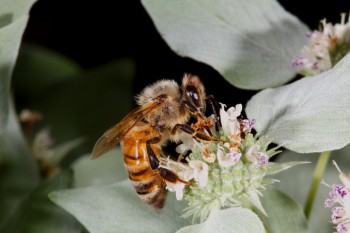We have a lot of European honey bees (Apis mellifera) this time of year, mostly on the mountain mint (Pycnanthemum muticum) but also on the other flowers that are blooming right now: black-eyed Susan, Buddleia, Conoclinium coelestinum, purple coneflower, and Asclepias tuberosa, among others. Contrary to what you may have been hearing, the world population of honey bees is steady or growing. In the USA, “the number of honey-producing colonies has been generally steady for about two decades and has risen four of the last five years – including an increase of over 100,000 hives last year. The bee population is up nearly 13 percent since 2008, recovering after the initial findings of colony collapse disorder.” Many people also are under the false impression that only honey bees are suitable pollinators for food producing plants. This leads to the also false impression that without honey bees, the country would become a barren wasteland. Remember, there were no honey bees in North or South America until they were brought here by European colonists. Many other bees, wasps, flies, butterflies, and moths pollinate flowers. Some of them are actually better pollinators than honey bees. Of course, they don’t have the significant fringe benefit of producing honey, and losing that would be a loss indeed.
Daily Archives: July 21, 2015
Apis mellifera (European Honey Bee)
Categories: Creatures
Comments Off on Apis mellifera (European Honey Bee)

